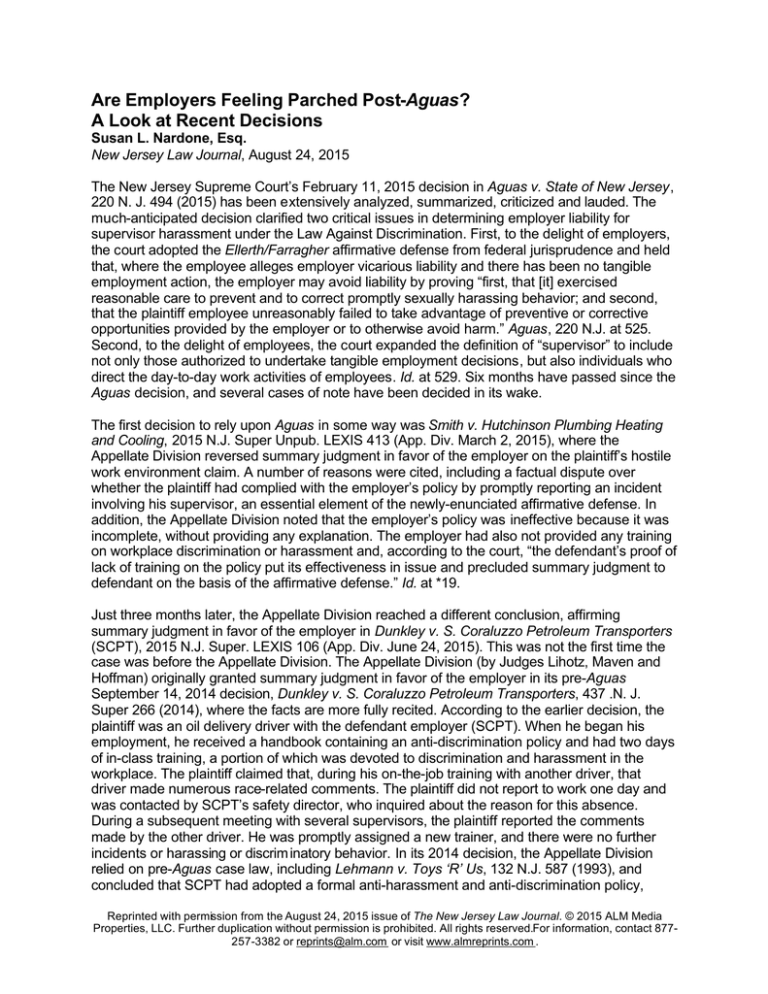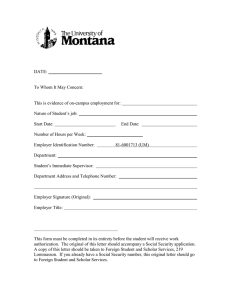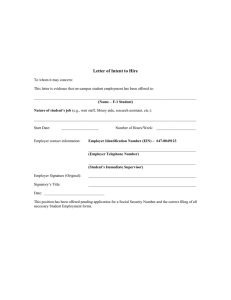
Are Employers Feeling Parched Post-Aguas?
A Look at Recent Decisions
Susan L. Nardone, Esq.
New Jersey Law Journal, August 24, 2015
The New Jersey Supreme Court’s February 11, 2015 decision in Aguas v. State of New Jersey,
220 N. J. 494 (2015) has been extensively analyzed, summarized, criticized and lauded. The
much-anticipated decision clarified two critical issues in determining employer liability for
supervisor harassment under the Law Against Discrimination. First, to the delight of employers,
the court adopted the Ellerth/Farragher affirmative defense from federal jurisprudence and held
that, where the employee alleges employer vicarious liability and there has been no tangible
employment action, the employer may avoid liability by proving “first, that [it] exercised
reasonable care to prevent and to correct promptly sexually harassing behavior; and second,
that the plaintiff employee unreasonably failed to take advantage of preventive or corrective
opportunities provided by the employer or to otherwise avoid harm.” Aguas, 220 N.J. at 525.
Second, to the delight of employees, the court expanded the definition of “supervisor” to include
not only those authorized to undertake tangible employment decisions, but also individuals who
direct the day-to-day work activities of employees. Id. at 529. Six months have passed since the
Aguas decision, and several cases of note have been decided in its wake.
The first decision to rely upon Aguas in some way was Smith v. Hutchinson Plumbing Heating
and Cooling, 2015 N.J. Super Unpub. LEXIS 413 (App. Div. March 2, 2015), where the
Appellate Division reversed summary judgment in favor of the employer on the plaintiff’s hostile
work environment claim. A number of reasons were cited, including a factual dispute over
whether the plaintiff had complied with the employer’s policy by promptly reporting an incident
involving his supervisor, an essential element of the newly-enunciated affirmative defense. In
addition, the Appellate Division noted that the employer’s policy was ineffective because it was
incomplete, without providing any explanation. The employer had also not provided any training
on workplace discrimination or harassment and, according to the court, “the defendant’s proof of
lack of training on the policy put its effectiveness in issue and precluded summary judgment to
defendant on the basis of the affirmative defense.” Id. at *19.
Just three months later, the Appellate Division reached a different conclusion, affirming
summary judgment in favor of the employer in Dunkley v. S. Coraluzzo Petroleum Transporters
(SCPT), 2015 N.J. Super. LEXIS 106 (App. Div. June 24, 2015). This was not the first time the
case was before the Appellate Division. The Appellate Division (by Judges Lihotz, Maven and
Hoffman) originally granted summary judgment in favor of the employer in its pre-Aguas
September 14, 2014 decision, Dunkley v. S. Coraluzzo Petroleum Transporters, 437 .N. J.
Super 266 (2014), where the facts are more fully recited. According to the earlier decision, the
plaintiff was an oil delivery driver with the defendant employer (SCPT). When he began his
employment, he received a handbook containing an anti-discrimination policy and had two days
of in-class training, a portion of which was devoted to discrimination and harassment in the
workplace. The plaintiff claimed that, during his on-the-job training with another driver, that
driver made numerous race-related comments. The plaintiff did not report to work one day and
was contacted by SCPT’s safety director, who inquired about the reason for this absence.
During a subsequent meeting with several supervisors, the plaintiff reported the comments
made by the other driver. He was promptly assigned a new trainer, and there were no further
incidents or harassing or discrim inatory behavior. In its 2014 decision, the Appellate Division
relied on pre-Aguas case law, including Lehmann v. Toys ‘R’ Us, 132 N.J. 587 (1993), and
concluded that SCPT had adopted a formal anti-harassment and anti-discrimination policy,
Reprinted with permission from the August 24, 2015 issue of The New Jersey Law Journal. © 2015 ALM Media
Properties, LLC. Further duplication without permission is prohibited. All rights reserved.For information, contact 877257-3382 or reprints@alm.com or visit www.almreprints.com .
Are Employers Feeling Parched Post-Aguas? A Look at Recent Decisions
Susan L. Nardone, Esq., New Jersey Law Journal
adopted a complaint procedure and investigation process, and distributed the policy to
employees and provided training. Moreover, the court held that the plaintiff had failed to take
advantage of the policy by reporting his concerns. Plaintiff’s efforts to attack the employer’s
policy and the procedures followed were rebuffed by the court: “[i]n hindsight, unquestionably,
one could suggest improvement in the depth of the process or the supervisors’ training on these
issues. Further publicizing the Human Resources or other office charged with enforcing the
procedures is preferable. However, we cannot conclude the methods used here fail to meet
established standards.”.
In March 2014, the New Jersey Supreme Court granted the employee’s petition for certification
and then immediately remanded the case to the Appellate Division in light of its decision in
Aguas, see 221 N.J. 217 (2015), with instructions to specifically consider whether there were
genuine issues of material fact that precluded summary judgment on the negligence and
vicarious liability claims against the employer. On remand, the Appellate Division relied on the
court’s analysis and holding in Aguas but did not reach a different conclusion. The court
analyzed the two distinct theories for employer liability in the same manner as the Aguas court,
finding that summary judgment remained the proper result. On the negligence claim, the plaintiff
argued that the employer did not satisfy all of the factors enunciated by the New Jersey
Supreme Court in Gaines v. Bellino, 173 N.J. 301 (2002). Among other things, the plaintiff
claimed that there was no effective monitoring of the policy’s effectiveness and that the
supervisors did not receive adequate training. In the court’s analysis of the various arguments
advanced by the plaintiff, a few points are worth noting. For one thing, it is clear that the
Appellate Division looked at the totality of the evidence before it, without focusing on one
possible infirmity in the employer’s process as a basis to deny summary judgment. For example,
the court was clearly persuaded by the fact that it was a supervisor’s inquiry to the plaintiff
concerning his absence from work that led to the revelation of the plaintiff’s complaints, not the
plaintiff’s own actions. Moreover, the employer took quick action to remedy the problem and the
plaintiff admitted there was no further discrimination or harassment. The court was persuaded
by these facts and not shaken by the “sparse” evidence on the existence of monitoring
mechanisms or by the employer’s decision not to fire the alleged discriminator. Not surprisingly,
the court also rejected the vicarious liability claim, once again focusing on the plaintiff’s failure to
report his concerns and the immediate action taken by the employer to enforce its policies. The
second Dunkley decision is interesting not only because it is the first case to meaningfully apply
Aguas but also because it does not apply an overly rigid standard.
The most recent post-Aguas decision came from Judges Fuentes, Ashrafi and O’Connor in
Jones v. Dr. Pepper Snapple Group, 2015 N.J. Super. Unpub. LEXIS 1848 (August 3, 2015).
The plaintiff alleged that, during a seven-month period in 2011 while working as a temporary
employee, she was subjected to sexual harassment by a supervisor. During that period, she did
not report the supervisor’s behavior. She was re-hired as a temporary employee in 2012 and
complained to a supervisor about the prior conduct. The second supervisor said that he would
take care of it, but then engaged in his own bad behavior, which was also not reported. Plaintiff
became a permanent employee and, for the first time, was given an employee handbook
containing the employer’s sexual harassment policy. She resigned soon thereafter and, at her
resignation, advised Human Resources of the harassment.
The employer conceded on summary judgment that the plaintiff had established a prima facie
case of hostile work environment sexual harassment but argued that it was not vicariously liable
because of its effective harassment policy and because the individuals involved were not the
plaintiff’s supervisors. The trial court granted summary judgment in favor of the employer and
the Appellate Division reversed. There was no dispute that the employer had an anti-
-2-
Are Employers Feeling Parched Post-Aguas? A Look at Recent Decisions
Susan L. Nardone, Esq., New Jersey Law Journal
discrimination and anti-harassment policy that contained formal and informal complaint
procedures. However, there was an issue of fact over whether the employer could show that it
had exercised reasonable care to prevent and correct sexually harassing behavior when it failed
to distribute its handbook to temporary employees like the plaintiff or to provide training on its
policies. The court reached a similar conclusion on the plaintiff’s vicarious liability claim, finding
that “[p]laintiff may not have endured—or at least may have been able to minimize—the sexual
harassment she experienced if defendant had advised her when initially hired as a temporary
employee of the remedies available in the event she were harassed.” Id. at *10. The court’s
decision raises some interesting questions for employers because quite often, temporary
employees are employees of the agency that supplied them and not of the company to which
they are assigned. As such, the company may not distribute its handbook to or train the
temporary employee on the company’s policies. The court’s decision implies that in that
instance, the company cannot avail itself of the defenses to liability that come with an effective
policy. The court did not decide whether the individuals involved in the alleged harassment were
the plaintiff’s supervisors, leaving that to the trial court on remand in light of the expanded
definition from Aguas.
After just six months, it is difficult to evaluate the true impact of the Aguas decision. Still, there is
something to be learned from the early adopters and interpreters of the Aguas decision by both
employers and employees. For employers, a robust, well-written anti-discrimination and antiharassment policy with formal and informal complaint and investigation procedures should be
accompanied by both supervisory and employee training, and then followed by periodic recirculation of the policy and monitoring of its effectiveness. This has long been the
recommended course for New Jersey employers, but Aguas raises the stakes, and employers
stand to lose a valuable defense for their non-compliance. For employees, taking advantage of
employer complaint procedures is imperative. To be sure, there are many reasons why
employees elect not to complain. However, that election could prove costly when future courts
scrutinize an employee’s own inaction in bringing complained-of conduct to an end.
-3-



